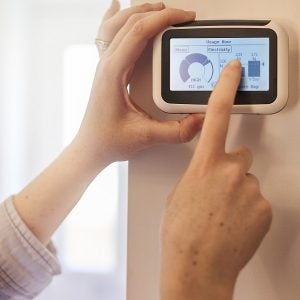What if gadgets talked to the grid to cut carbon? With this new technology, they can.
 Having breakfast at a local restaurant last weekend, I was sitting next to parents who were desperately trying to get their toddler to eat the pancakes he had ordered a few minutes earlier. Watching the high-stakes drama, it occurred to me that toddlers are a bit like our electric grid: They can change drastically at a moment’s notice.
Having breakfast at a local restaurant last weekend, I was sitting next to parents who were desperately trying to get their toddler to eat the pancakes he had ordered a few minutes earlier. Watching the high-stakes drama, it occurred to me that toddlers are a bit like our electric grid: They can change drastically at a moment’s notice.
The better we are at reacting to the sudden outburst of “I hate pancakes” – or in the case of the grid, rapid changes in demand, price and emissions – the better off we’ll be.
For emissions at least, we can. Automated Emissions Reductions, or AER, is a new technology helping us to more precisely measure and proactively reduce the carbon emissions impact from our electricity use, in real time. A growing number of grid operators, businesses and energy managers nationwide are lining up to invest in this technology as an efficient way to cut their carbon footprint.
Ever-changing grid poses challenges
Much like the minds of toddlers, the emissions impact of electricity on the grid can change minute to minute.
Grid conditions such as demand, transmission constraints and wholesale market prices along with factors like weather, wind speed and cloud cover all determine the so-called marginal power mix.
In general, at any given moment, the cheapest power plant on the grid that has spare capacity is the marginal unit and will respond to fluctuating electricity demands by increasing or decreasing production. The carbon emissions from that marginal unit are known as marginal emissions.
What if gadgets talked to the grid to cut carbon? With this new technology, they can. Share on XNew algorithm syncs power use with clean energy
By focusing on the marginal emissions on minute-to-minute intervals, AER helps users identify opportunities to reduce electricity use from dirtier power plants by timing their demand to when cleaner plants are the marginal unit. It lets them drive emissions reductions more effectively compared with traditional approaches that track average emissions rates with hourly intervals.
AER uses a first-of-a-kind algorithm to crunch real-time marginal emissions, grid conditions and electricity market data to identify opportunities for devices and consumers to cut pollution and use more renewable energy.
It sends minute-to-minute updates on actual emissions conditions on the grid to systems or devices that use electricity, adjusting usage as the marginal power mix changes throughout the day.
For example, AER software offered by organizations such as WattTime will let you “tune” a building’s energy system, an electric vehicle fleet or even an individual appliance like your air conditioner to automatically reduce emissions by syncing their electricity use with clean power on the grid.
Some more examples:
- AER is now live in devices like EMotorWerks EV chargers and Energate smart thermostats allowing consumers to proactively and automatically shift the timing of their home heating and cooling, as well as the charging of their electric vehicle
- California’s Self Generation Incentive Program is considering using AER to monitor greenhouse gas impacts of energy storage – which, surprisingly, is not always clean.
- Boston University just became the first organization to use AER to identify locations on the grid that have the greatest potential for displacing fossil fuels. It will allow BU to more than double the environmental impact of a new wind farm it built.
- Microsoft is building a tool to make AER more widely available. The Smart Energy Azure Demonstration platform will help companies see in real time the emissions impact of their operations via the Azure service.
70% of our power use is candidate for AER
WattTime research suggests that 70 percent of United States electricity use is coming from devices that are partly flexible about exactly when to run. It represents a huge, untapped opportunity to combat climate change and transition to clean energy more efficiently.
As any parent dealing with temper tantrums knows, real-time signals for toddlers are unfortunately still out of reach. The growing use of real-time emissions signals, on the other hand, will – and is beginning to – help consumers, utilities and companies drive decarbonization in very tangible ways.










